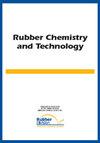Data-Driven Identification of hyperelastic models by measuring the strain energy density field
IF 1.5
4区 工程技术
Q4 POLYMER SCIENCE
引用次数: 0
Abstract
This paper presents a novel method for accurately identifying the large strain elastic response of elastomeric materials. The method combines the Data-Driven Identification (DDI) algorithm with a unique heterogeneous experiment, deviating from the conventional approach of conducting multiple simple experiments. The primary objective of the method is to decouple the experimental process from the fitting technique, relying instead on a single comprehensive experiment to generate an extensive collection of stress and strain energy fields. This collection is then utilized in conjunction with a standard fitting technique to determine the parameters of hyperelastic models. Notably, the approach places significant emphasis on the strain energy density field as a critical factor in model identification, as it encompasses the full material response within a single scalar quantity. To demonstrate the effectiveness of the proposed approach, a proofof-concept is provided using synthetic data. The results highlight the efficiency of the method and emphasize the importance of incorporating the strain energy density field for precise model identification, surpassing the reliance on stress data alone. Additionally, the paper introduces several graphical tools to evaluate and analyze the quality of both the generated mechanical fields and the identification results. The proposed approach offers a more comprehensive representation of the material behavior, and enhances the reliability and prediction capabilities of hyperelastic material models. It holds significant potential for advancing the field of solid mechanics, particularly in accurately characterizing the mechanical responses of elastomeric materials.基于应变能密度场的超弹性模型数据驱动识别
提出了一种准确识别弹性体材料大应变弹性响应的新方法。该方法将数据驱动识别(Data-Driven Identification, DDI)算法与独特的异构实验相结合,摆脱了传统的进行多个简单实验的方法。该方法的主要目标是将实验过程与拟合技术解耦,而是依靠单一的综合实验来生成广泛的应力和应变能场集合。然后将此集合与标准拟合技术结合使用,以确定超弹性模型的参数。值得注意的是,该方法非常强调应变能密度场作为模型识别的关键因素,因为它包含了单个标量内的全部材料响应。为了证明所提出方法的有效性,使用合成数据提供了概念验证。结果表明了该方法的有效性,并强调了结合应变能密度场对精确模型识别的重要性,而不是仅仅依赖应力数据。此外,本文还介绍了几种图形化工具,用于评价和分析生成的力学场和识别结果的质量。该方法更全面地描述了材料的行为,提高了超弹性材料模型的可靠性和预测能力。它在推进固体力学领域,特别是在精确表征弹性体材料的力学响应方面具有重要的潜力。
本文章由计算机程序翻译,如有差异,请以英文原文为准。
求助全文
约1分钟内获得全文
求助全文
来源期刊

Rubber Chemistry and Technology
工程技术-高分子科学
CiteScore
3.50
自引率
20.00%
发文量
21
审稿时长
3.6 months
期刊介绍:
The scope of RC&T covers:
-Chemistry and Properties-
Mechanics-
Materials Science-
Nanocomposites-
Biotechnology-
Rubber Recycling-
Green Technology-
Characterization and Simulation.
Published continuously since 1928, the journal provides the deepest archive of published research in the field. Rubber Chemistry & Technology is read by scientists and engineers in academia, industry and government.
 求助内容:
求助内容: 应助结果提醒方式:
应助结果提醒方式:


